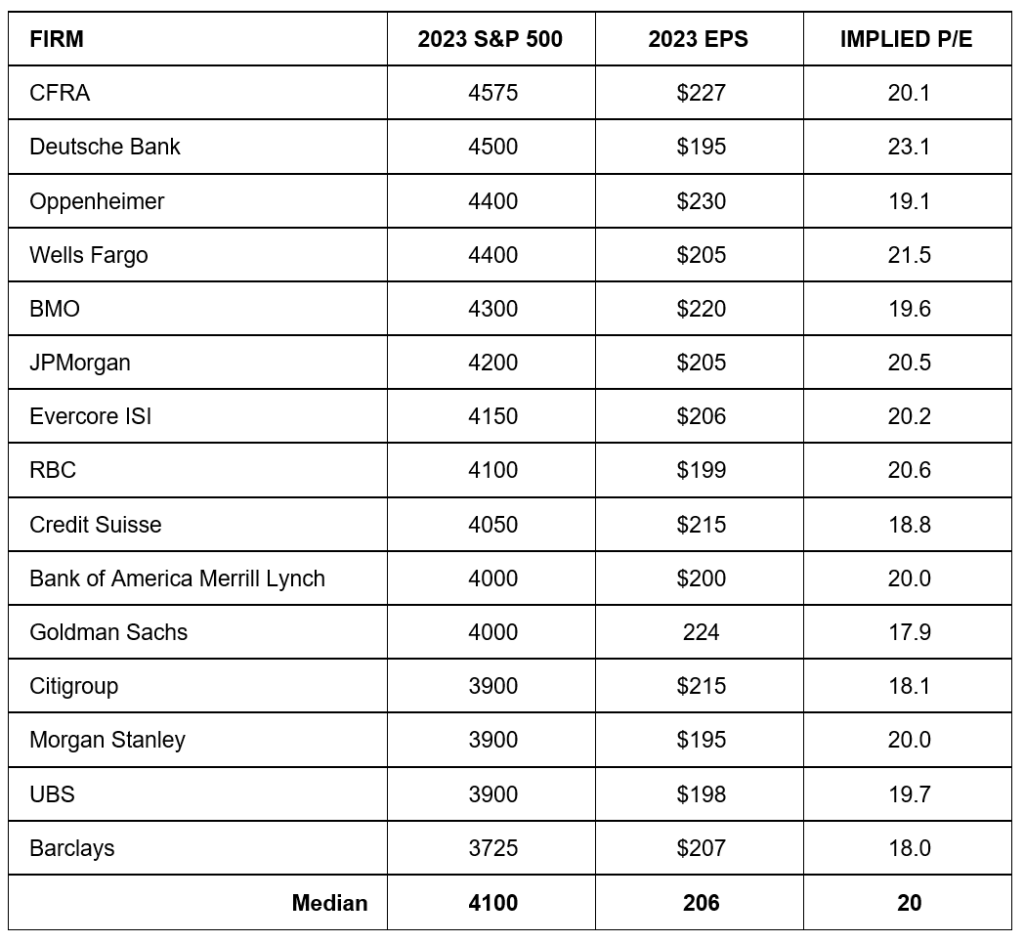It’s that time of the year and Wall Street strategists offer their 2023 outlook for the S&P 500 Index year end target. It’s that time of the year when smart people, discuss with other smart people, look at a lot of data and come up with a guess. Yes, a guess. Let’s keep this post in mind at the end of the year.
I’ve stated many times before, EVERYONE has an opinion. Even experienced investment professionals with the same access to the same data, technology, personnel can come up with different conclusions of what an investment will return over some time period. The problem is that most people want precision forecasting when it doesn’t really exist. Think of investment forecasts as the weather forecast, but the weather forecast probably has less bias, emotions, career risk, and other factors that investment forecasts have.
Investors that offer forecasts are paid to offer those forecasts. Most of these forecasts have a human element to them, which means that the person or team may not want to offer a forecast that much different from the rest of the other strategists. If the average forecast is X, one will probably want to stay relatively close to that average to try to avoid being that wrong relative to everyone else.
Those that offer extreme views that are very different from the average are often doing so for publicity. Anyone can say “I think the market will fall 50%” It’s easy to sell gloom and doom. Then if the market does sell off 50%, that person looks like a genius and they live on that “big call” for their entire career. We have seen that time and time again.
Oh, and oftentimes strategists will change their year end forecasts if the markets go up or down significantly during the year. If a strategist has a year end target of 4500, but the market declines to 3500 past the year’s half way mark, the strategist may feel pressure to reduce their year end target so as to not be embarrassed by such an incorrect call. the strategist will claim “unforeseen events” to bring the forecast down. Same thing on the upside. If the forecast is 4500 and the market rallies to 5200, don’t be surprised if the strategist raises their year end target siting “better than expected” outcomes.
Again, strategists are paid to make short-term forecasts, but I bet they don’t like doing it. I personally find no benefit in doing it or focusing on the short-term. I’d rather have the market come to me, not pretend to accurately predict the short-term future.
2023 S&P 500 Index Year End Forecasts
Below is a list of investment firm strategists’ 2023 S&P 500 Index year end forecasts. Based on simple math, one way to get an estimate for an equity investment is taking the forecasted earnings per share (EPS) and multiply it by a price-to-earnings (P/E) ratio. If the EPS or P/E ratio changes, the value would change. If you have conviction in the EPS or P/E ratio for the S&P 500 or any equity investment, feel free to make your own forecast.
Estimated Value = EPS x P/E
As you can see below, the range of forecasts is relatively wide, between 3725 and 4575 on the index and almost 29% difference. Or, rather than using any of the forecasts, use the median value, which is calculated at 4100. Maybe the S&P 500 ends the year at 4100, or maybe not. Ok, now pick which one will be correct at the end of the year. Good luck.

S&P 500 Index Return for 2023?
Let’s just do some quick math. If the S&P 500 Index ended 2022 at roughly 3840 and the year end 2023 value ends up being 4100, that is an approximate 6.7% return. Then add on a 1.5% dividend yield and the total return forecast for the S&P 500 Index for 2023 would be 8.2%. Not bad, if only these forecasts were guaranteed reality, which they are not.
Back to the strategists’ forecasts. It’s funny, anytime I see these forecasts, they generally end up being a roughly 8% return for the new year, regardless of what’s happening in the markets or economy. I think 8% is always just the baseline for the strategists. Since markets have historically gone up roughly 70% of the time, and averaged 8-10% a year, these strategists may not want to go against history and forecast a negative year. Look at 2022. Think the strategists’ forecasts for 2022 were having the S&P 500 index down 20%? Nope.
What To Consider Instead
I don’t put much credence on these outlooks and forecasts. They are just human beings and based on my experience, have never been that accurate in predicting the future time and time again. Some of those forecasters will be closer to the actual year end value, some will be higher, and some will be lower. The “winner” is never consistent each year. If you “felt good” about the market and made an investment decision based on the most bullish forecaster, then in reality, the market tanks 20%, are you going to complain to that forecaster? No. If a “talking head” on the news claims the market will fall 50% and it makes you nervous and you are sitting in cash, then the market rallies 20%, how will that make you feel? Not great. Again, good luck in picking the right forecast, I just wouldn’t rely on it that much.
If Wall Street forecasts aren’t all that reliable for any given year, as they are just educated guesses and trying to predict the future, what should you consider instead? Maybe just focus on the long-term, focus on investments you understand, then let the markets come to you. If the markets sell off significantly in 2023, then maybe add risk if it is suitable to do so. If the markets do nothing, maybe do nothing. If the markets rally significantly, then maybe reduce some risk or just rebalance you portfolio if it is out of tolerance.
Keep it simple, ignore the short-term noise, focus on higher quality investments over the long-term, buy low and sell high. Simple.
Sources
1. CNBC. CNBC Market Strategist Survey. WALL STREET’S 2023 OUTLOOK. Retrieved from https://www.cnbc.com/market-strategist-survey-cnbc/, January 15, 2023.
